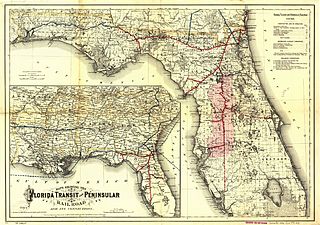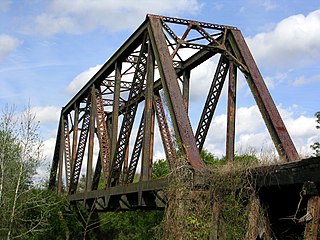
The Florida Central and Peninsular Railroad was the final name of a system of railroads throughout Florida, becoming part of the Seaboard Air Line Railway in 1900. The system, including some of the first railroads in Florida, stretched from Jacksonville west through Tallahassee and south to Tampa. Much of the FC&P network is still in service under the ownership of CSX Transportation.
The Charleston and Savannah Railway was a 19th-century American railroad serving the coastal states of South Carolina and Georgia and running through part of the South Carolina Lowcountry. Its name varied slightly over time:
The Savannah, Americus and Montgomery Railway (SA&M) was a historic railroad located in the U.S. states of Georgia and Alabama. SA&M was built in the 1880s running between Montgomery, Alabama and Lyons, Georgia. It would be completed to Savannah, Georgia in 1896 after being renamed the Georgia and Alabama Railway. The line would notably become part of the Seaboard Air Line Railroad network in 1900.

The Riceboro Southern Railway began operations in 2004 operating on about 33 miles of track, some of which is leased from CSX Transportation. The track on which it operates is part of the ex-Seaboard Air Line route from Savannah, Georgia to Jacksonville, Florida. It runs generally from Ogeechee, Georgia, where the line splits from the CSX Savannah Subdivision, which is the former Atlantic Coast Line Railroad's Savannah-Jacksonville route, and Riceboro. It does not have any of its own locomotives; it uses Georgia Central power.

Coosawhatchie (koo-saw-HATCH-ee) is an unincorporated community and census-designated place (CDP) located in Jasper County, South Carolina, United States at the northern head of the Broad River. It served as the headquarters for General Robert E. Lee during the early part of the American Civil War. It was first listed as a CDP in the 2020 census with a population of 57. It is accessible from Interstate 95 via Exit 28.
The Green Pond, Walterboro and Branchville Railroad was a railroad that ran from Green Pond, South Carolina northwest to Ehrhardt, South Carolina.
The Charlotte Harbor and Northern Railway is a historic railroad line that at its greatest extent serviced Gasparilla Island in Charlotte Harbor and a major shipping port that once operated there. The railroad's principal purpose was to transport phosphate mined along the Peace River and in the Bone Valley region of Central Florida to the port to be shipped. It also brought passengers to the island community of Boca Grande on Gasparilla Island, and is largely responsible for making Boca Grande the popular tourist destination it is today. Part of the line remains in service today between Mulberry and Arcadia, which is now owned and operated by CSX Transportation. Today, it makes up CSX's Achan Subdivision and part of their Brewster Subdivision.

The Seaboard–All Florida Railway was a subsidiary of the Seaboard Air Line Railroad that oversaw two major extensions of the system in the early 1920s to southern Florida on each coast during the land boom. One line extended the Seaboard's tracks on the east coast from West Palm Beach down to Fort Lauderdale and Miami, while the other extension on the west coast extended the tracks from Fort Ogden south to Fort Myers and Naples, with branches from Fort Myers to LaBelle and Punta Rassa. These two extensions were heavily championed by Seaboard president S. Davies Warfield, and were constructed by Foley Brothers railroad contractors. Both extensions also allowed the Seaboard to better compete with the Florida East Coast Railway and the Atlantic Coast Line Railroad, who already served the lower east and west coasts of Florida respectively.
Dale, South Carolina, is an unincorporated community and census-designated place (CDP) located in northern Beaufort County in the southern corner of the state of South Carolina, U.S.A. It was first listed as a CDP in the 2020 census with a population of 633.
The Savannah Subdivision is a railroad line owned by CSX Transportation in the U.S. state of Georgia. Through the middle of Savannah, the Savannah Subdivision splits into an east route and a west route. The East Route runs from Savannah, Georgia, to Ogeechee, Georgia, for a total of 15.6 miles (25.1 km). At its north end it continues south from the Charleston Subdivision and the Columbia Subdivision both of the Florence Division and at its south end it continues south as the Nahunta Subdivision. The West Route is located in Savannah, Georgia, and is 9.7 miles (15.6 km) in length. At its north end it branches off of the Savannah Subdivision East Route and at its south end it comes back into the Savannah Subdivision East Route.
The Wildwood Subdivision is a railroad line owned by CSX Transportation in Florida. It runs along CSX's S Line from Baldwin south to Zephyrhills via Ocala and Wildwood for a total of 155.7 miles. The S Line is CSX's designation for the line that was the Seaboard Air Line Railroad main line from 1903 to 1967.

The Charleston Subdivision is a railroad territory owned by CSX Transportation in the U.S. states of South Carolina and Georgia. The line from Florence, South Carolina, to Savannah, Georgia, for a total of 195.8 miles. At its north end it continues south from the South End Subdivision and at its south end it continues south as the Savannah Subdivision of the Jacksonville Division.

The CSX A Line forms the backbone of the historic Atlantic Coast Line Railroad Main Line, the backbone of their network in the southeastern United States. The main line runs from Richmond, Virginia to Port Tampa just southwest of Tampa, Florida, a distance of nearly 900 miles. Along its route it passes through Petersburg, Rocky Mount, Florence, Charleston, Savannah, Jacksonville, and Orlando. With the exception of a short 61-mile segment in Greater Orlando, the entire line is owned by CSX Transportation.

The Seaboard Air Line Railroad's Sarasota Subdivision was a rail line that ran from the company's main line at Turkey Creek south to Palmetto, Bradenton, Sarasota, and Venice. The line was built in phases from 1901 to 1911.
The Atlantic Coast Line Railroad's DuPont—Lakeland Line was a historic rail line in southern Georgia and the northern west coast of Florida. On employee timetables, the line was actually divided into the DuPont—High Springs Line and the High Springs—Lakeland Line. The line was primarily used for freight, though some passenger services ran on parts of it in Florida. While parts of the line were built as early as 1863, the full line was not complete until 1913. Parts of the line in Florida are still active today.
The Seaboard Air Line Railroad’s Main Line was the backbone of the Seaboard Air Line Railroad's network in the southeastern United States. The main line ran from Richmond, Virginia to Tampa, Florida, a distance of over 800 miles. Along its route it passed through Petersburg, Raleigh, Columbia, Savannah, Jacksonville, and Ocala, Florida. While some segments of the line have been abandoned as of 2023, most of the line is still in service and is owned by the Seaboard Air Line's successor, CSX Transportation as their S-Line.

The Carolina Central Railroad, was a railway company in the United States. It was incorporated in 1855 as the Wilmington and Charlotte Railroad and was renamed the Wilmington, Charlotte and Rutherford Railroad shortly after. It was reorganized as the Carolina Central Railway in 1873. It built 152 miles (245 km) of track, in two unconnected sections, in the southern part of North Carolina. The company was again reorganized as the Carolina Central Railroad in 1880. In 1900, the Carolina Central Railroad was merged into the Seaboard Air Line Railroad. Its lines are now owned by CSX Transportation.
The Atlantic Coast Line Railroad's Waycross—Montgomery Line was one of the company's secondary main lines running from Waycross, Georgia west to Montgomery, Alabama, a distance of over 300 miles. It was built in the late 1800s by the Atlantic Coast Line's predecessor companies. The line is still in service today and is now the Thomasville Subdivision and Dothan Subdivision of CSX Transportation, the Atlantic Coast Line's successor company through various mergers.
The Atlantic Coast Line Railroad's Florence—Robbins Line was one of the company's secondary main lines that ran from Florence, South Carolina to Robbins. It was built in the late 1800s and large parts of it were built by the Atlantic Coast Line's predecessor companies. Parts of the line are still in service.
The Atlantic Coast Line Railroad's Parkton—Sumter Line was one of the company's secondary main lines running between Parkton, North Carolina and Sumter, South Carolina.









